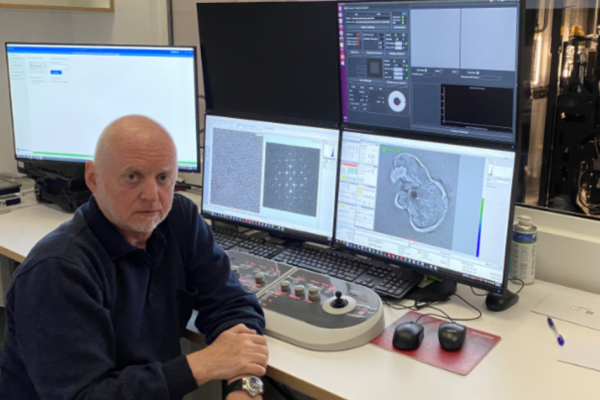ESTEEM3 interviews : Miran CEH from Jožef Stefan Institute.

Miran CEH is the head of the Center for Electron Microscopy at Jozef Stefan Institute. Within ESTEEM3 project, he is the leader of the workpackages 1, 2 and 3.
In this interview, Miran CEH will explain his background, his role, and his views about ESTEEM3.
Question 1: Tell us something about yourself, your background, and your team
I have joined the Ceramics department at the Jožef Stefan Institute in Ljubljana, Slovenia, as a young chemist right after my bachelor’s degree which is quite long time ago. I was almost immediately assigned to run the Mark V dedicated electron microprobe with two horizontal WDS spectrometers and with computing power less than first mobile phones. Later I have started to work on my first TEM (Jeol 2000FX) but have got really involved in TEM when I specialized in STEM (VG 501 HB) at the MPI in Stuttgart (prof. Rühle’s group). Not much later I have become responsible to run microscopy centre at the Jožef Stefan Institute which I still do today besides my research at the Nanostructured Materials department and other assignments among them also lecturing.
Question 2: Tell us briefly about the last original research you have conducted
I have always been involved in both areas, i.e. electron microscopy and synthesis/processing of materials with defined physical properties. In the field of electron microscopy we have been working on quantitative interpretation of the HAADF HR STEM images quite from the beginning of method. Currently, we are putting efforts into quantitative interpretation of the in-situ liquid cell TEM, also studying electrochemistry. In materials science my interest was for many years investigation of materials with the perovskite structure for dielectric and ferroelectric applications. The content of those studies was to study how internal boundaries such as RP-type faults and/or AP boundaries influence the grain growth in polycrystalline materials. My most recent research in materials science however are pstudying processed to enable transformation of HEA into HEO for catalytic applications in ecology and energy.
Question 3: Present your institute and its tasks within ESTEEM3?
The Jožef Stefan Institute in Ljubljana is the largest research institute in Slovenia with app. 1200 employees. It covers different areas of research such as physics, chemistry, electronics, AI, life science, etc. The major research infrastructures (RI) of the institute are joined into instrumental centres, among them is also the Center for Electron Microscopy and Microanalysis (CEMM) which comprises the JSI RI for electron microscopy; scanning electron microscopy, transmission electron microscopy and sample preparation. The CEMM in principal employs personnel, who maintain the equipment and perform specific analytical tasks for the JSI departments and other interested partners, although many departments employ their own dedicated microscopists that use the equipment within the CEMM. Nevertheless, the official partner of the ESTEEM consortium is the Nanostructured materials department who is involved in all three ESTEEM3 activities, namely JRA, NA and TA.
Question 4: Why did you decide to be a part of the ESTEEM3 project?
Initial attempt to form a European network of institutes/centers that have the equipment and expertise in the field of transmission electron microscopy, so called TEM-NET consortium, was unfortunately not accepted for EU funding. Later, when the first ESTEEM consortium was formed it was not really self-evident that all the TEM-NET partners would continue to be ESTEEM consortium members. So it was not really our decision to be part but have been invited to participate. However, I myself and my colleagues have always tried to be constructive and helpful partner also in lobbying processes to assure that EU would announce a specific call that the ESTEEM consortium could apply to. This also may have helped that we could have joined the consortium, besides our developing TEM expertise.
Question 5: What are the most challenging aspects of your role and how do you overcome them?
The ESTEEM3 project and its carrying out had quite specific problems compared to previous ESTEEM projects. It is quite clear that the Covid situation had negative influence on carrying out the EU/national projects in general and the ESTEEM3 was no exception. In the JRA it was not possible/easy to freely travel so the collaboration was quite difficult. The same was for the NA. Most of the schools/workshops were therefor organized only in the last year of the project. For me, as the NA co-coordinator of the project, this presented maybe somehow more tangible worry, however all the partners have really tried hard to fulfil the original NA plan. Also for the TA it is not the same if the TA partners are present live when analytical work is performed or they just follow the analytical work via on-line or just by sending the samples. Personal interaction in carrying out investigation is crucial.
However, for me professionally the Covid time was actually quite good. I was one of the rare exceptions at the JSI that was not working from home since we decided to keep the CEMM equipment running during the pandemic. Never have I experienced so much peace at work. And this past ESTEEM3 period was really good for upgrading the existing EM RI at the JSI since we got new Spectra 300, Talos, two new SEM's and shortly a new FIB.
Question 6: What is the added value of ESTEEM3 for the European research?
All the key performance indicators that were set for the ESTEEM3 project were well met and most of them surpassed. There is no doubt that the ESTEEM3 project is a very successful project and I believe that it will be widely recognised as such. The JRA activity ensured that the methodology for various electron microscopy techniques was justly addressed within a single EU platform. This means that also other institutes/centres with electron microscopy RI will benefit from publicly available results obtained during the project via publications, protocols, software, etc. The schools and workshops organized be the ESTEEM3 consortium attracted roughly 600 participants at the on-site events. Even more researchers were reached through online webinars. Finally, provided TA projects enabled many EU and international groups to access state-of-the-art electron microscopy RI thus helping them with the results in their research. It is not overstated to claim that the added value to the European research is large and relevant.
Question 7: What do you expect for the future of the project?
Unfortunately, there are no suitable calls for projects within the Horizon Europe so that the ESTEEM consortium (existing/modified) could apply to. The strategy of the EU research policy seems not to support networking between institutions with complementary instrumentation/expertise which is to my opinion not a very good decision. Another observation during all three ESTEEM projects (ESTEEM, ESTEEM2, ESTEEM3) is also that more and more importance was given to providing TA on expense of performing basic science within the project which is also debatable whether this is good or bad. Furthermore, the EU only supports large pan European research infrastructures (ESFRI,…) and it seems that the RI for electron microscopy does not qualify easily as such. Summing up, I am not very optimistic that there will be an easy way to enable future existence/financing for the ESTEEM consortium in current form. The offspring e-DREAM will hopefully continue the quest with the help of all of us and maybe we will be able to constitute an electron microscopy ERIC in the near future.
Read all our interviews here.
